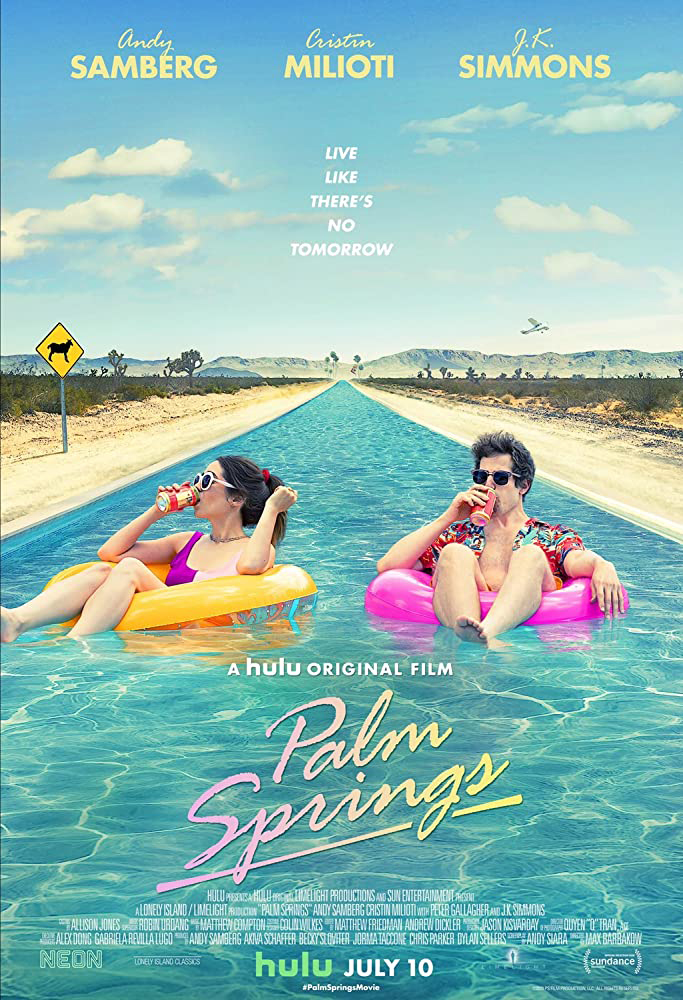![]() Max Barbakow’s directorial debut is another entry in the long line of media about time loops. In this riff on the phenomenon of a person repeating a single day, Andy Siara’s screenplay presents an intriguing complication. The place is a resort in Palm Springs. The day is November 9. The event is a wedding for a seemingly perfect couple. Nyles is the boyfriend of the bride’s close friend. Sarah is the bride’s black-sheep sister. But, their problems are only beginning when what was, at first, a recurring time-loop for affable jokester Nyles, becomes more critical when an accidental rendezvous traps Nyles in that recurring time-loop with Sarah. How do you deal with a recurring world where there are no stakes when the only one to measure your purgatory against is a stranger? You fall in love, naturally.
Max Barbakow’s directorial debut is another entry in the long line of media about time loops. In this riff on the phenomenon of a person repeating a single day, Andy Siara’s screenplay presents an intriguing complication. The place is a resort in Palm Springs. The day is November 9. The event is a wedding for a seemingly perfect couple. Nyles is the boyfriend of the bride’s close friend. Sarah is the bride’s black-sheep sister. But, their problems are only beginning when what was, at first, a recurring time-loop for affable jokester Nyles, becomes more critical when an accidental rendezvous traps Nyles in that recurring time-loop with Sarah. How do you deal with a recurring world where there are no stakes when the only one to measure your purgatory against is a stranger? You fall in love, naturally.
To be fair to “Palm Springs” it’s both more and less complicated than this. Even as “Palm Springs” is more comedic than romantic, Barbakow and Siara immediately set up the chemistry between Adam Samberg’s affable Nyles and Cristin Milioti’s sceptical Sarah. Their ultimate romantic pairing isn’t treated as a question, but as the bedrock that the film is built on. We know it before they do. What the film questions is whether the two can break out of the nightmare loop they find themselves trapped in.
Like any film that depends on something so impossible, the set-up trumps the solution. It makes sense, that in a film about an infinite time-loop – the setting up the loop is more compelling than its resolution. The first act of the film, as Siara’s script sets up the complications, establishes the parameters of the world and builds up a number of problems for the pair, is the film’s most assured. Barbakow is in sharp control of this world-building. But no time-loop can ceaselessly build without complications, and it seems natural that as the issues of Nyles and Sarah grow in the middle of the film, “Palm Springs” becomes just as aesthetically and thematically messy.
But, then, messy as a formal or narrative tool in a film about chaotic people feels like a realistic choice. And “Palm Spring” binds itself to the messy wildness of these two central characters. It’s a choice that pays off. Both Samberg and Milioti harness a similar ambivalence in their varying cadences that make them seem effectively matched – especially in the first hour of the film. Samberg’s ambivalence is couched in a humour that is both self-deprecating and careless. Milioti is sharper. In a way she’s playing the straight-man to Samberg’s zany comedian. She’s not asked to be funny, so much as she’s able to modulate the film’s central zaniness with a sincerity that is sharp, but not maudlin.
The film is at its best when the two are together. But as “Palm Springs” deepens, like any time-loop story it begins to wrestle with the ethics and philosophy of life and change and hope and possibility. One effective stylistic turn throughout the film is the way that Barbakow’s direction performs misdirection on the passage of time. We are never quite certain how much time the pair spent trapped in this time loop. It’s hard not to read the current pandemic into banality the pair finds themselves in, day after day after day. As the film builds to its climax, it allows the pair to separate – following their adventures in separate extended sequences. And it’s here that “Palm Springs” most consistent issue emerges.
When things take a turn towards the dramatic in the final act, it feels essential and valuable but the game is so stacked towards Milioti’s empathetic cadence, that it feels uneven. Siara’s script is not quite certain how to modulate Nyles penchant for diffidence into a proper dramatic arc, and the one that comes for him (bound up in the romance part of the romantic-comedy) feels less impactful than the more sincere dramatic arc that Milioti goes through. As the film nears its end, the moment of greatest emotional clarity is a simple scene of Milioti giving a tearful speech that feels removed from the more chaotic mood of comedy the film is more devoted to culling. In a way, it makes sense for “Palm Springs”. Individual moments do not always cohere. A subplot with J.K. Simmons feels too deliberate and wraps up with too much obvious symbolism to feel organic. Dale Dickey is fun in a bit role but feels too incidental. There’s a lot going in here that feels larger than a 90-minute film. But even when the parts of the whole don’t cohere, “Palm Springs” is unceasingly warm and pleasant.
Palm Springs is available on Hulu.





